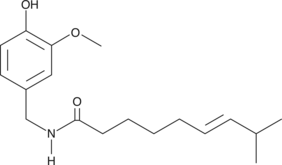Description
A terpene alkaloid; induces inward currents in HEK293 cells expressing rat TRPV1 (EC50 = 0.64 µM at neutral pH); decreases LPS-induced PGE2 production, as well as reduces LPS- and IFN-induced NO release in isolated mouse peritoneal macrophages at 10 and 50 µM; induces substance P release in rat spinal cord slices (EC50 = 2.3 µM); reduces acetylcholine- or phenylquinone-induced writhing (ED50s = 1.33 and 1.38 mg/kg, respectively, s.c.) but has no effect on the latency to paw withdrawal in the hot plate test in mice (ED50 = >20 mg/kg, s.c.)
Formal name: N-[(4-hydroxy-3-methoxyphenyl)methyl]-6E-8-methyl-nonenamide
Synonyms:
Molecular weight: 305.4
CAS: 404-86-4
Purity: ≥95%
Formulation: A crystalline solid
Product Type|Biochemicals|Ion Channel Modulation|Activators||Product Type|Biochemicals|Natural Products|Alkaloids||Product Type|Biochemicals|Natural Products|Terpenes||Product Type|Biochemicals|Ox Stress Reagents|Antioxidants||Research Area|Immunology & Inflammation|Inflammatory Lipid Mediators|Prostaglandins||Research Area|Immunology & Inflammation|Innate Immunity||Research Area|Neuroscience|Pain Research



